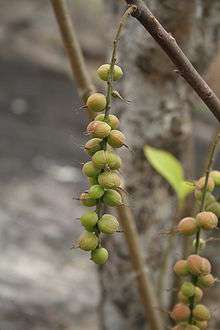Alchornea cordifolia
| Alchornea cordifolia | |
|---|---|
 | |
| Scientific classification | |
| Kingdom: | Plantae |
| (unranked): | Angiosperms |
| (unranked): | Eudicots |
| (unranked): | Rosids |
| Order: | Malpighiales |
| Family: | Euphorbiaceae |
| Subfamily: | Acalyphoideae |
| Tribe: | Alchorneae |
| Subtribe: | Alchorneinae |
| Genus: | Alchornea |
| Species: | A. cordifolia |
| Binomial name | |
| Alchornea cordifolia Müll.Arg. | |
| Synonyms | |
|
Schousboea cordifolia | |
Alchornea cordifolia is a shrub or small tree distributed throughout tropical Africa. The plant is used in traditional African medicine.
Chemical constituents
The leaves, roots and stem bark contain terpenoids, steroid glycosides, flavonoids, tannins, saponins, carbohydrates and the imidazopyrimidine alkaloids alchorneine, alchornidine, and several guanidine alkaloids. The leaves also contain a range of hydroxybenzoic acids: gallic acid and its ethyl ester, gentisic acid, anthranilic acid, protocatechuic acid, and ellagic acid (alizarine yellow). A C20 homolog of vernolic acid named alchornoic acid can be found in the seed oil.[1]
References
External links
- Dressler, S.; Schmidt, M. & Zizka, G. (2014). [http://www.africanplants.senckenberg.de/root/index.php?submitForm=true&page_id=77&searchTextMenue=Alchornea+cordifolia&filterRegionIDs[]=6&filterRegionIDs[]=1&filterRegionIDs[]=2&filterRegionIDs[]=3&filterRegionIDs[]=5 "Alchornea cordifolia"]. African plants – a Photo Guide. Frankfurt/Main: Forschungsinstitut Senckenberg.
This article is issued from Wikipedia - version of the 4/1/2016. The text is available under the Creative Commons Attribution/Share Alike but additional terms may apply for the media files.